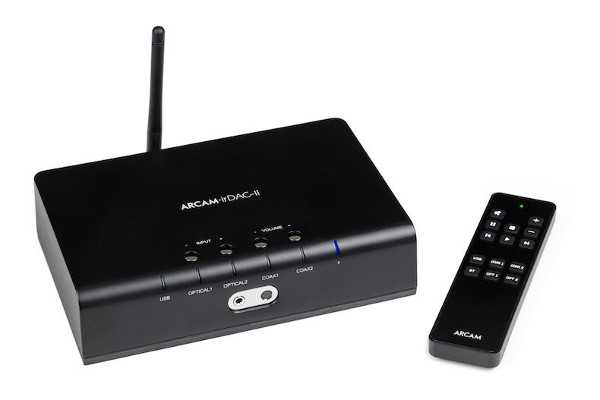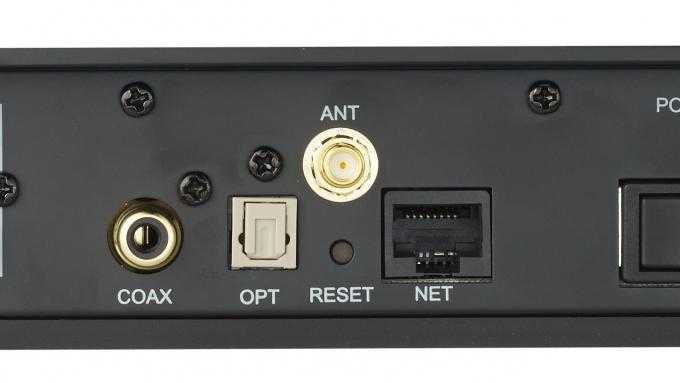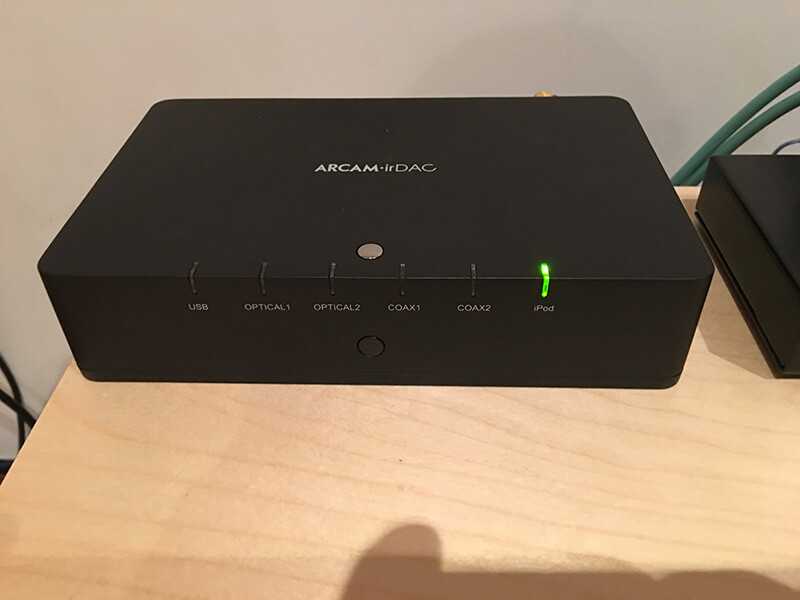Новый внешний ЦАП Arcam irDAC-II теперь доступен в России
Английская компания A&R Cambridge Ltd, разрабатывающая и реализующая на национальных рынках большинства стран мира интегрированные усилители, предусилители, усилители мощности, AV ресиверы, BD плееры и CD проигрыватели под брендом Arcam FMJ, акустические системы под брендом Arcam Solo, аудио конвертеры miniBlink Bluetooth и внешние цифрово-аналоговые преобразователи линейки rSeries airDAC, rBlink (беспроводные), rPAC, irDAC, запустила в производство новый продукт Arcam irDAC-II, впервые представленный на международной выставке CES 2016, на рубеже марта-апреля текущего года и сегодня внешний ЦАП Arcam irDAC-II с USB, SPDIF, optical портами, поддержкой Bluetooth и Wi-Fi стал доступным в России.
Свой первый внешний ЦАП A&R Cambridge Ltd представила на мировом рынке еще в 1987 году и учитывая растущий спрос на гибридные продукты, способные работать в роли точки доступа и медиарендерера (Digital Media Renderer), почти 3 десятка лет формировала линейку rSeries из моделей на базе наиболее прогрессивных технологий. Arcam irDAC-II в традиционном для внешних ЦАП бренда литом алюминиевом корпусе, нивелирующим риски «микрофонного» эффекта и блокирующим помехи из-за внешних наводок, включает асинхронный USB DAC, цифровой предварительный усилитель, усилитель для наушников (заимствован из флагманского усилителя A49), поддерживает DSD128, беспроводной протокол передачи Bluetooth aptX и базируется на чипе ESS ES9016 Sabre.
Как и Arcam airDac внешний ЦАП Arcam irDAC-II способен обеспечивать функции медиарендерера для доступа к аудио контенту локальной сети, работать в роли точки доступа, формируя собственную Wi-Fi-сеть с устройствами, поддерживающими стандарт 802.11 b/g/n, однако из Arcam irDAC-II производитель убрал порт LAN, интегрировав в заднюю панель порты iPod USB ‘A’, два оптических, два коаксиальных и 4 выходных порта Fixed/Variable Line Out.
Впечатляюще низкий шум и практическое отсутствие искажений при передаче аудио контанта на наушники или внешнюю акустику обеспечивается за счет стабилизированного источника питания, четырехслойных печатных плат и заимствованной у референсной серии FMJ технологии подавления джиттера. Интегрированный в Arcam irDAC-II чип Sabre DAC, ESS ES9016K2M поддерживает 16 и 24 битное аудио, DSD128, входной Bluetooth – кодеки SBC, AAC, aptX, aptX-LL, выходной каскад усилителя для наушников — более высокий уровень импеданса (между 30 Ом — 600 Ом на 3,5 мм штекер). Поддерживаемые Arcam irDAC-II частоты дискретизации — USB: 32кГц, 44,1 кГц, 48 кГц, 88,2 кГц, 96 кГц, 176.4kHz, 192kHz, 384 кГц; оптический: 44.1, 48кГц, 88,2, 96кГц; коаксиальный: 44,1, 48кГц, 88,2, 96кГц, 176.4kHz, 192kHz, диапазон воспроизводимых частот от 20 Гц до 20 кГц (+/: 0.1dB) при коэффициенте нелинейных искажений (плюс шум) менее 0.0007% и отношении сигнал/шум 117dB (24: bit).
Как и другие продукты rSeries внешний ЦАП Arcam irDAC-II имеет компактный, стильный форм фактор, при размерах 194 мм (глубина) х 44 мм (высота без антенны Wi-Fi приемника/передатчика) х 124 мм (ширина) Arcam irDAC-II весит 1.1 кг, может эксплуатироваться в настольном или навесном (настенном) положении, поставляется со вмеси необходимыми кабелями и разъемами для коммутации с другими устройствами.
Подробнее о бренде Arcam
СЛЕДУЮЩАЯ НОВОСТЬ
Onkyo TX-RZ710 – THX сертифицированный, 7.2-канальный сетевой AV ресивер
ПРЕДЫДУЩАЯ НОВОСТЬ
Ресивер, превращающий мечты в реальность — Onkyo TX-RZ810
|
Главная страница > Новости > Новинки > Новый внешний ЦАП Arcam irDAC-II теперь доступен в России
Sound quality
Where do we start? Well, how about by revealing that we like the irDAC. A lot. Across all inputs, this small black box gives music a quite breathtaking sense of rhythm.
Play a CD-quality file of Ella Fitzgerald’s and the Arcam captures the vibe of the track perfectly. There’s detail aplenty, with the DAC picking out the delicate piano play, lazy double-bass and Ella’s silky-smooth and beautifully controlled vocal.
But not only does it allow you to pick out the fine details, it’s the way the machine knits, gels and intertwines all the various elements together that really gets your heart going.
Iggy Azalea’s has a couple of complex elements and the track can sound lost and confused with inferior kit. But the Arcam has no trouble with a 256kbps stream from Spotify through its USB connection.
The pounding bassline sounds tight and weighty, and while the Arcam sounds more rounded than it does neutral, highs still display sharpness and precision.
For timing and accuracy this DAC is going to be tough to beat. And for those of you wondering whether it’s better than the old rDAC? The words ‘different’ and ‘league’ spring to mind. This model sounds bigger, bolder, more detailed and more cohesive.
A legacy lives on in style
In 1976 two engineering students at Cambridge University with a passion for electronics and music founded Amplification and Recording Cambridge (Arcam). In 1988 they produced the first stand-alone DAC then as time went on many other iconic products. Then a few years ago they released the highly acclaimed irDAC that impressed audio fans far and wide. Today I’ll be looking at the successor of that product Arcam irDAC-II.
Disclaimer: The Arcam irDAC-II was loaned to me by a local distributor – Mungkong Gadget for the purpose of this review. I do not gain financially from this collaboration and all opinions stated here are my own based on my time spent with the product.
Pros
- Beautifully crafted
- Excellent headphone amp
- Versatile input options
- Bluetooth/wireless connection
Cons
Conclusion
The Arcam irDAC-II is a solid product and well suited to be at the centre of your digital audio experience. Beautifully crafted, loaded with features and producing a warm, neutral sound at an affordable price and it also looks sweet on the desktop. DACs are ever increasing in popularity due to the surge of digital sources and integration with things like Spotify and Tidal and Arcam are leaping right into the fray with confidence.
The included remote control is icing on the cake. This would probably have been given a 5-star rating if not for the volume buttons and no switching between headphone amp and line out although this is just my opinion and might not be an issue at all for others. The sound and build of the irDAC-II however, is fantastic and easily worth 4.5/5 stars. If you’re looking for a DAC and a high-quality headphone amplifier this is well worth considering. Recommended.
You can buy the Arcam irDAC-II on Amazon HERE.
Характеристики
Гарантия: Двухлетний RTB, подробности: www.arcam.co.uk, Код детали: airDAC
Мы были впечатлены Arcam rBlink и тем, как он позволяет вам передавать музыку по беспроводной сети с любого устройства с поддержкой Bluetooth на набор динамиков или Hi-Fi. Arcam airDAC использует другой подход, обеспечивая беспроводную потоковую передачу через беспроводные протоколы Apple Airplay и UPnP.
Корпус airDAC, размещенный в привлекательном литом алюминиевом корпусе размером 190x120x44 мм, имеет сдержанный полностью черный дизайн, но выглядит немного устаревшим. На задней панели airDAC имеется большой выбор соединительных портов, включая стереофонические RCA-выходы и оптический и коаксиальный цифровые выходы S / PDIF для подключения airDAC к существующему оборудованию. В airDAC используется чип Texas Instruments Burr Brown PCM5102, который представляет собой тот же цифроаналоговый преобразователь (ЦАП), который используется в Arcam rBlink и Arcam miniBlink.
Вы можете подключить airDAC к вашей сети через Ethernet-соединение или по беспроводной сети. Досадно, что вам нужно выключить и снова включить airDAC, если вы хотите изменить тип сетевого подключения, как вы можете сделать это только при загрузке. Настроить беспроводное соединение несложно, и вы можете использовать airDAC без проводов одним из двух способов. AirDAC может либо создать собственную беспроводную сеть, к которой подключено ваше устройство, либо подключиться к существующей сети Wi-Fi.
После того, как airDAC подключится к вашей сети, ПК или мобильному устройству, вы сможете передавать на него аудио с помощью Apple AirPlay. Вы сможете использовать Apple AirPlay, если у вас есть устройство iOS, такое как iPhone или iPad, или если у вас есть iTunes на вашем ПК или ноутбуке. Вы также можете бесплатно загрузить собственное приложение Arcam для iOS под названием Songbook и использовать его для потоковой передачи музыки.
AirDAC совместим с UPnP, и вы можете использовать UPnP для потоковой передачи музыки по беспроводной сети из нескольких источников, поддерживающих протокол, включая ПК, устройства Android, музыкальные серверы или устройства NAS. Мы протестировали airDAC через AirPlay с iPhone 5S и UPnP с Nexus 7 (используя приложение BubbleUPnP для Android) и обнаружили, что соединение было надежным.
AirDAC поддерживает воспроизведение файлов без потерь вплоть до 24-битной глубины и частоты дискретизации 96 кГц по UPnP, но AirPlay ограничивает вас дорожками 16 бит / 48 кГц. Как и в случае с Arcam rBlink, мы обнаружили, что airDAC обеспечивает детальное и насыщенное звучание, которое, безусловно, соответствует наследию Arcam.
Arcam airDAC — отличный способ добавить поддержку AirPlay и UPnP к вашей hi-fi или аудиосистеме, и мы были рады найти все необходимые кабели, поставляемые в коробке. За 400 фунтов стерлингов это большие инвестиции, но для тех, кто ищет высококачественный беспроводной ЦАП с отличным качеством звука, этот Arcam airDAC является отличным выбором.
| Покупка информации | |
|---|---|
| Цена с учетом НДС | £400 |
| Гарантия | Двухлетний RTB |
| поставщик | www.richersounds.com |
| подробности | www.arcam.co.uk |
| Код детали | airDAC |
Build
The Arcam seems to get bigger with every version. Gaining slightly in width and depth over the irDAC, the (only just) desktop-friendly irDAC-II is the size of a chunky book – and similar in shape too thanks to the aluminium casework’s rounded front.
It’s solid in your hand and, while more practical than plush when it comes to aesthetics, is well finished too.
Buttons adorn the top, making it a tactile, hands-on unit that doesn’t leave so much power in the hands of the remote (which is still supplied in a similar form, just without a power button).
MORE: best DACs 2016
Two input buttons mean you don’t have to skip through all six inputs. There’s another two for volume, although we’d prefer a twisty dial or knob for easier, more intuitive control.
And, if we were to make a snag list, the ability for the Arcam to indicate what sampling rate is being input would be on it.
Along the front, a light for each input turns from red to green when a signal is detected.
Once Bluetooth is selected, pressing the two optical input buttons at the same time initiates pairing, and the flashing purple light goes solid when a connection is established.
In case you haven’t guessed, easy access to the manual is useful.
Features
If you are familiar with the irDAC range, you’ll see from first glance that it’s from the same gene pool as its predecessors. The changes more than justify the tacked-on roman numerals though, and include new internal circuitry, a headphone amplifier stage, and the adoption of an ES9016 Sabre DAC.
Arcam’s engineers have worked “obsessively” to further reduce jitter by focusing on isolating the digital and analogue stages, power supplies and a direct couple signal path.
The headphone output stage has been taken from Arcam’s flagship A49 amplifier too, and aptX Bluetooth (via way of antennae) replaces the Apple-friendly USB type-A input found on the irDAC.
Last but not least, there’s now DSD128 support through the asynchronous USB input, as well as PCM support up to 24bit/384kHz.
There are also two coaxial inputs, capable of handling files up to 192kHz, and two optical sockets limited to 96kHz.
As for outputs, there are fixed and variable analogue sockets so you can choose whether or not to hand over volume controls to another component in your system.
The irDAC-II is nothing if not well equipped around the back, leaving its front to bear the 3.5mm headphone output.
Function and sound
The Arcam irDAC-II has a fluid yet detailed presentation while reproducing audio faithfully and without colouring. Instrument separation and soundstage is exquisite, especially when using the headphone amp. The headphone amp incidentally was taken directly from Arcam’s flagship amp the A49 and paired with the ES9016 Sabre DAC it’s a formidable combination. There is absolutely no background noise evident when listening.
As I mentioned above I would prefer a traditional volume knob for fine adjustments but this is just nitpicking as the provided buttons work perfectly well.
Listening to Marcin Wasilewski’s “Spark of Life” album the imaging and tonal neutrality are wonderful, with the piano and bass notes sounding warm and rich and at the same time high-hats and cymbals are crisp and natural without any hint of scratchiness. With Mathias Eick’s “Midwest” I was really impressed with the soundstage and again with imaging, being able to place the instruments with ease. Throughout testing the irDAC-II stayed cool as a cucumber, barely getting any warmer than in its powered off state.
When using the RCA line out (both fixed and variable) there’s no way to switch between headphone amplifier and line out, so when you insert headphones the speakers continue to output sound. This seems like a rather large oversight and I’d like to see a more elegant solution such as the one used on the JDS Labs Element.
Pairing with Bluetooth was a breeze with my Samsung Galaxy Note 5 and worked flawlessly. Some purists might wonder at the inclusion of Bluetooth on a DAC of this quality but obviously, it’s a convenience and if you’re sitting down for some critical or analytical listening you’d most likely use a different input method. For my tastes, though it’s really handy for certain situations, such as a friend who’s visiting and wants to share their new favourite music with you – just pair their phone up with the irDAC-II and you’re good to go. Oh and hope your friend doesn’t have awful (from your point of view) taste in music.
JDS Labs Element
As far as inputs go the irDAC-II is the obvious winner here unless you need an analogue in. Both of these DACs have impressive headphone amps with enough power to drive just about anything you can throw at them. I prefer the volume control knob of the Element and the button to switch between the amp and line out is something I feel is sorely missing on the Arcam model.
The Element seems slightly more aggressive in its presentation compared to the more refined and subtle irDAC-II so for me this would come down to personal preference. I’d give the irDAC-II a slight edge in sound but prefer the user-friendly nature of the Element. Another factor for deciding would be the price with the Element currently retailing for $349US and the irDAC-II at roughly $641US (or £269 vs £495 respectively).
FX-Audio DAC-X6
This is not really a fair comparison considering the price difference but the FX-Audio holds up well in terms of inputs. It has almost the same amount of digital input options excluding Bluetooth (USB, Coaxial, Optical) albeit only 1 of each. The DAC-X6 only has a fixed level RCA output but has a traditional style volume knob which earns it extra points.
As you’d expect when it comes to the power and quality of the headphone amp the Arcam comes out on top. Build quality on the irDAC-II really stands out as it is heavy and solid as if there’s no empty space inside (there was no way I was going to open it just to find out!) whereas the DAC-X6 feels like an aluminium box with some PCB inside. Keep in mind though the irDAC-II comes in at almost x10 the price of the FX-Audio unit.
Connections
The irDAC offers a full suite of connections. Twin optical and twin coaxial digital inputs will take the feed from streamers, CD players, TVs, games consoles and so on. There’s also a Type-B USB input.
This is of the asynchronous variety, which means it controls the data flow and not the computer – theoretically resulting in better sound. A switch on the back changes the USB connection between Class I and Class II status (Class II is for feeding the Arcam a 24-bit/192kHz high-resolution stream).
There’s also a Type-A connection. This lets you hard-wire an Apple device and let the Arcam convert the digital signal to analogue. It also charges your portable.
The irDAC is mains powered, but can also be juiced-up by the separate power supplies found in some of Arcam’s other products, such as the A19 stereo amp. Arcam claims this will further improve sound quality.
The “i” in irDAC indicates you get a remote control in the box, unlike its predecessor. The small wand looks and feels cheap, but at least you can change inputs from afar and control the playback and volume of connected portables and compatible media-playing software.
Freebie optical digital and USB-cables are thrown in to get you started too, but you could always look to upgrade these further down the line. There’s also a power cable with foreign plug adaptors in the box.
Sound
Maintaining the traditional sonic signature of Arcam’s amplifiers, the irDAC-II has plenty of muscle; in Ray LaMontagne’s Part One — Hey, No Pressure (24bit/96kHz), guitar riffs sound meaty with just the right amount of edge.
Generous amounts of detail stretch to every corner of the Arcam’s big, expansive soundstage, and are delivered on a tonally even-handed palette that’s refined and smooth.
It’s easy to get caught up in the presentation’s full, weighty disposition, but there’s also the space, clarity and precision to ensure his strained vocals and drum strokes are just as articulate.
Even a Spotify stream over Bluetooth sounds decently clean and clear, avoiding that congested, muggy presentation that often plagues low-res files and streaming.
MORE: DACs – everything you need to know
The solid low-end has a real presence as the Arcam knuckles down on the droning, distorted bass line in Iggy Pop’s American Valhalla with conviction and agility. A twinkling transparency to the xylophone notes opening the track confirms the irDAC-II’s sweet, open treble too.
While Iggy’s tremulous croons are clear and focused beneath, there is a shortage of midrange solidity and dynamic expression, which a comparison with the Chord Mojo is only too keen to show up. It overlooks the subtler inflictions in his delivery, and even at this price that makes all the difference.
As we move to Michael Jackson’s Working Day and Night (24bit/96kHz), the Arcam isn’t quite as rhythmically snappy or musically fluid as the Mojo either, having a slightly looser stranglehold over the track’s nippy 129-beat-per-minute tempo.
We can’t help but feel that the Arcam drags its heels a little, lacking the verve and sense of convincing enthusiasm to get us toe-tapping along quite so avidly.
Build
The irDAC-II feels very solid and reassuring in the hand. The housing is beautifully crafted from cast aluminium. All the edges are rounded and smooth, presenting a premium impression. The front edge curves over the front of the unit, revealing six pinstripe LEDs (one for each input). The LEDs change colour from red to green when a signal is detected through the selected input.
Near the top-front edge are 4 round buttons – 2 for input selection and another 2 for volume control. Personally, I would have preferred a rotary style volume control but this is partly negated by the option of a fixed level RCA output, which allows you to take control of the volume from an external pre-amp or amp. The front panel is bare apart from the 3.5mm headphone jack and an IR sensor.
On the rear panel, we find the host of digital input options. Fixed and variable RCA, 2 x optical, USB and coaxial. There’s also the power switch, power jack and screw terminal for the Bluetooth antenna.
Maximum supported sampling rates are as follows:
- USB: 24-bit, 384kHz
- Coaxial: 24-bit, 192kHz
- Optical: 24-bit, 96kHz
- Bluetooth SBC, AAC, aptX, aptX:LL
On the bottom of a unit is a rubber base that covers the entire under section. It’s a practical addition as it prevents scratching of the surface the DAC sits on, however, the rubber is a little too hard which results in the unit sliding easily on your desk when inserting or removing headphones.
Equipment used
- Windows 10, Gigabyte Z170x Gaming 7, Samsung Galaxy Note 5
- foobar2000
- Pioneer VSX-329 Receiver
- Kingston HyperX Cloud, DQS* D200*, Senfer 4in1, SHOZY Zero, Tennmak Pro, HLSX-808
- Elac B6 bookshelf speakers
Music tested
- Solar Fields – “Altered – Second Movements” full album
- Marcin Wasilewski Trio – “Spark of LIfe” full album
- The Pineapple Thief – “Your Wilderness” full album
- Wiener Symphoniker, Philippe Jordan “Schubert Symphonies Nos. 7 & 8
- Mathias Eick – “Midwest” full album
Packaging and accessories
The irDAC-II comes in a cardboard box that feels and looks premium. The front of the box is black with irDAC-II in large white print and an image of the DAC itself. The back is white with black text outlining the specifications, features and included accessories and a picture of the rear casing showing all the input options.
Specifications
- Dimensions 194 x 124 x 44mm
- Net weight: 1.1kg
- Power supply: 12V DC, 1.5A
- Inputs: 1 x USB Class II, 4 x SPDIF , 1 x Bluetooth
- Outputs: 2.15V RMS RCA phono, 0-2.15V RMS RCA phono, headphone
What’s in the box
- irDAC-II digital to analogue converter
- Power adaptor with interchangeable plugs
- Infrared remote control
- Bluetooth antenna
- Stereo phone audio interconnect
- Coaxial digital interconnect
- Optical digital interconnect
- USB type-A to type-B cable
- Quick start guide
Features
- Links your digital audio sources to you Hi-Fi
- aptX CODEC
- High resolution up to 24-bit 384kHz
- DSD128 support
- Line output with volume control
- High quality headphone output
- De-jitters incoming data
- Infra-red remote control
- All necessary audio cables included
As you can see there are plenty of accessories included and inside the box, you’ll have everything you need to get up and running.
The remote control unit is refreshingly simple. There are playback and volume controls on the top section. Below are separate buttons for each of the input methods. The buttons have a nice tactile click which is something rarely seen and I like these a lot. It uses 2 AAA batteries and it’s a nice remote which, like everything else here exudes quality.
1 место — Fujida Karma Bliss WiFi: Характеристики и цена
Fujida Karma Bliss WiFi
В рейтинге комбо-устройств 3 в 1 занимает первое место модель Fujida Karma Bliss WiFi. Данный видеорегистратор выделяется стабильностью работы радарной части, удобным управлением, а также постоянным обновлением ПО. В сумме с производительным процессором данная модель выделяется на фоне других.
| Тип | С экраном; |
| Количество камер | 1 шт |
| Разрешение | 1920×1080 при 30 к/с |
| Функции | датчик удара (G-сенсор), GPS, ГЛОНАСС, детектор движения в кадре |
| Угол обзора | 170° |
| Экран | 3 дюйма; |
| Обнаружение радаров | «Автоураган», «Арена», «Визир», «Кречет», «Крис», «Robot», «Автодория», «Кордон», «Стрелка», «Циклоп», «Вокорд», «Одиссей», «Mesta», «Беркут», «Поток-С», «Радис», «Сокол» |
| Цена | 12 999 ₽ |
Угол обзора камеры 4.7/5
Удобство крепления 4.8/5
Качество съёмки днём 4.8/5
Качество съёмки ночью 4.9/5
Удобство управления 4.8/5
Итого: 4,8/5
Fujida Karma Bliss WiFi: Преимущества и недостатки
+ Качество картинки как в ночное, так и в дневное время суток;
+ Стабильная работа радарной части;
+ Оповещение о стационарных камерах с высокой точностью;
+ Удобство управления;
+ Качественная сборка и такие же сборочные материалы;
+ Компактность размеров модели;
+ Удобство обновления ПО при помощи Wi-Fi;
+ Не привлекает к себе лишнего внимания;
+ Адекватная стоимость при высоком функционале модели;
+ Наличие интеллектуального фильтра, который снижает количество ложных срабатываний;
+ Возможность подключения второй камеры;
+ Высокотехнологичный процессор нового поколения;
+ Обнаружение камер контроля светофоров и автобусных полос;
+ Быстрое подключение к GPS спутникам;
+ Наличие фильтра скорости;
+ Большой угол обзора;
+ Видит номера проезжающих автомобилей;
+ Стабилизация изображения;
+ Крепление с активной зарядкой;
+ Простота эксплуатации;
— Минусы не обнаружены;




















































